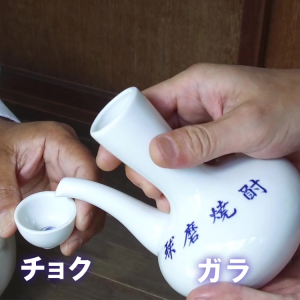“gala” “choku”
The home of Kuma Shochu (the distilled rice spirit) is the Kuma Region which surrounds Hitoyoshi City in Kumamoto Prefecture. In the Kuma region, the customary way of drinking this deep and strong beverage with 35-40% alcohol is to pour it into a “gala”, a container that looks like a flask with a long spout. The shochu is then heated on a stove top and served. Kuma Shochu cups, known as “choku” are smaller than sake cups, and the opening is not very wide. Since shochu used to be served in a wooden box that held “2-gou-5-shaku” in the ancient measurement (equivalent of approximately 15.25 oz, or 433ml), the gala was designed to contain the same amount. It is large enough to add some hot water to adjust the intensity of the shochu. The preferred material for the gala and choku is white porcelain made in the famous Arita Region (in the neighbouring prefecture Saga.) Arita producers make them specifically to meet the demand from the Kuma Region. Due to this, the gala and choku are found only in the Kuma Hitoyoshi region. The size of the choku cup is small in order to soften the sharp aroma of heated Shochu. The slim spout of the gala makes it easy to pour shochu into the tiny choku. Since the gala is made of porcelain, it does not break on direct heat and therefore is convenient for warming up the shochu within it. There is another shape of Kuma Shochu cup called a “solagyu”. It has a pointed bottom similar to that of the spinning top toy, and tilts to the side when rested on a flat surface. As such, you have to finish the cup in order to place it down on a table. The shape of solagyu reflects the alcohol-loving culture and history of Kuma Hitoyoshi region. The name solagyu comes from a typical social exchange by locals. The host serves shochu to a guest, saying “Here you go” (“sola”), and the guest drinks it up (a gesture sometimes described as “gyu” in Japanese).


